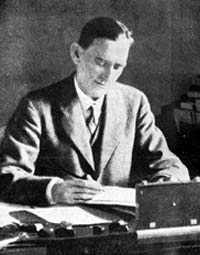Sir John Marshall | |
|---|---|
Sir John Marshall working at his desk  | |
| Born | 19 March 1876 Chester |
| Died | 17 August 1958 (aged 82) |
| Nationality | British |
| Citizenship | British |
| Alma mater | King's College, Cambridge |
| Known for | excavations in Harappa, Mohenjodaro, Sanchi, Sarnath, Taxila, Crete and Knossos |
| Awards | CIE Knighthood FBA |
| Scientific career | |
| Fields | History, Archaeology |
| Institutions | Archaeological Survey of India |
| Influences | James Prinsep, H. H. Wilson, John Leyden, Henry Thomas Colebrooke, Colin Mackenzie and William Jones |
Sir John Hubert Marshall CIE FBA (19 March 1876, Chester, England – 17 August 1958, Guildford, England) was the Director-General of the Archaeological Survey of India from 1902 to 1928.[1] He oversaw the excavations of Harappa and Mohenjodaro, two of the main cities that comprise the Indus Valley Civilization.
Personal history and career
Marshall was educated at Dulwich College as well as King's College, Cambridge.[2] In 1898, he won the Porson Prize.[3]
In 1902, the new viceroy of India, Lord Curzon, appointed Marshall as Director-General of Archaeology within the British Indian administration. Marshall modernised the approach to archaeology on that continent, introducing a programme of cataloguing and conservation of ancient monuments and artefacts.
Marshall began the practice of allowing Indians to participate in excavations in their own country. In 1913, he began the excavations at Taxila, which lasted for twenty years. In 1918, he laid the foundation stone for the Taxila Museum, which today hosts many artifacts and one of Marshall's few portraits. He then moved on to other sites, including the Buddhist centres of Sanchi and Sarnath.
His work provided evidence of age of Indian civilisation especially Indus Valley Civilization and Mauryan age (Ashoka's Age). Following the lead of his predecessor Alexander Cunningham, Marshall, in 1920, initiated at dig at Harappa with Daya Ram Sahni as director. In 1922, work began at Mohenjo-Daro. The results of these efforts, which revealed a seeming ancient culture with its own writing system, were published in the Illustrated London News on 20 September 1924. Scholars linked the artifacts with the ancient civilisation of Sumer in Mesopotamia. Subsequent excavation showed Harappa and Mohenjo-Daro to be sophisticated planned cities with plumbing and baths.[4]
Marshall also led excavations at the prehistoric Sohr Damb mound near Nal in Baluchistan; a small representative collection of pottery vessels from the site is now in the British Museum.[5] He is also known for his important part in excavations at Knossos and various other sites on Crete between 1898 and 1901 .
Marshall was appointed a Companion of the Order of the Indian Empire (CIE) in June 1910[6] and knighted in January 1915.[7]
Publications
- Marshall, John (ed.) (1931). Mohenjo-Daro and the Indus Civilization.
- Marshall, John H. (1960). The Buddhist Art of Gandhara: the Story of the Early School, Its Birth, Growth and Decline. Cambridge: Cambridge University Press.
- Marshall, John H. (1960). A Guide to Taxila (4th ed.). Cambridge: Cambridge University Press.
- Marshall, John H.; M. B. Garde (1927). The Bagh Caves in the Gwalior State. London: The India Society.
- Marshall, John H.; Foucher, Alfred. The Monuments of Sanchi (3 vol.).
- Marshall, John H. (1918). A Guide to Sanchi. Calcutta: Superintendent, Government Printing.
In British Academy
Sir John Marshall was elected a Fellow of the British Academy in 1936 .
See also
- Indus Valley Civilization
- R. D. Banerji
References
- ^ "Banerji robbed of credit for Indus findings".
- ^ "Marshall, John Hubert (MRSL895JH)". A Cambridge Alumni Database. University of Cambridge.
- ^ The India List and India Office List for 1905, London: Harrison and Sons, 1905, p. 562.
- ^ Jane McIntosh, The Ancient Indus Valley: New Perspectives ; ABC-CLIO, 2008; ISBN 978-1-57607-907-2 ; pp. 29–32.
- ^ British Museum Collection
- ^ London Gazette, 23 June 1910
- ^ London Gazette, 9 March 1915
External links
- J. H. Marshall, "The Date of Kanishka", Journal of the Royal Asiatic Society of Great Britain and Ireland, 1914, pp. 973–986.
- Sir John Marshall, A Guide to Taxila. Calcutta: Superintendent Government Printing, India, 1918, archive.org.
- "Sir John Hubert Marshall", britannica.com.
| Preceded by James Burgess | Director General of the Archaeological Survey of India 1902 - 1928 | Succeeded by Harold Hargreaves |